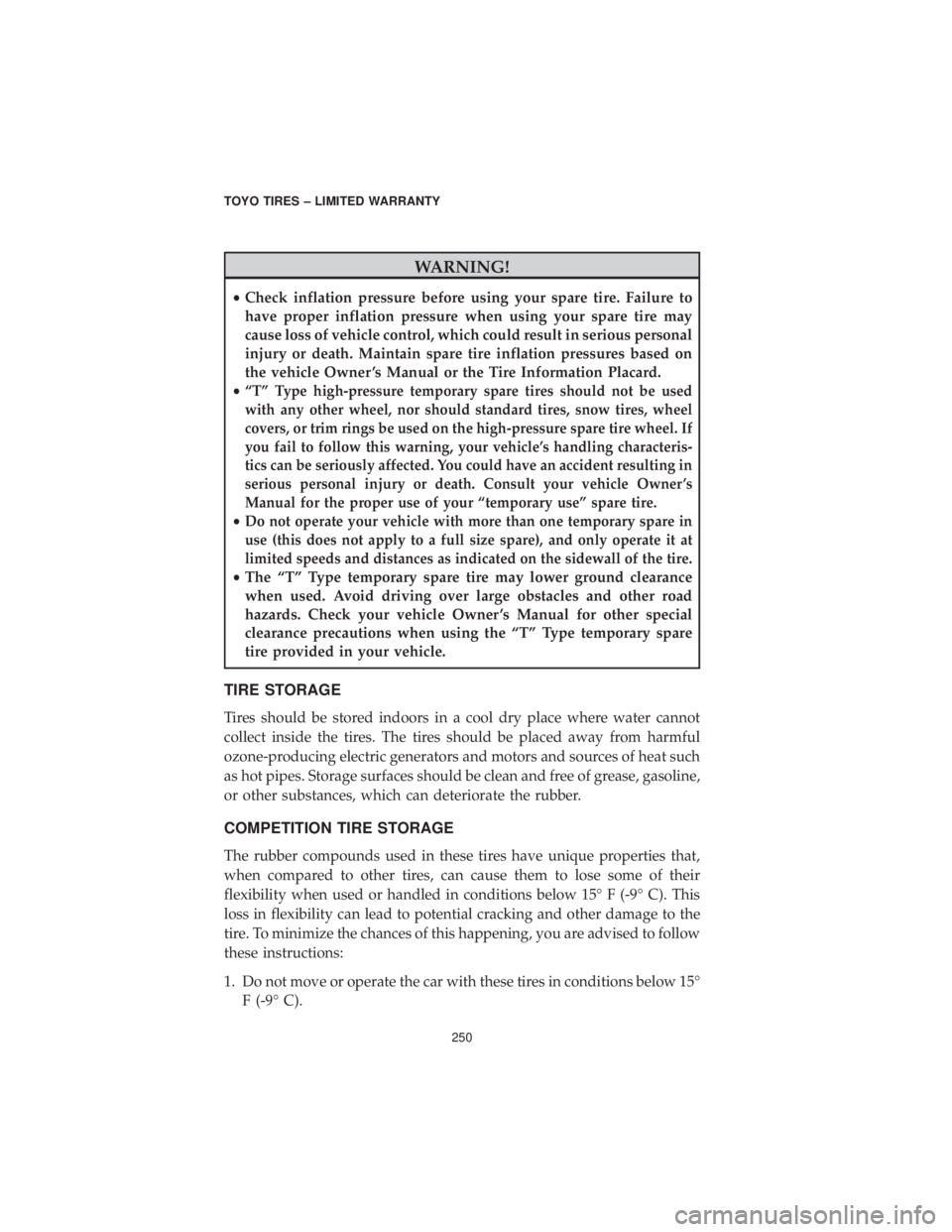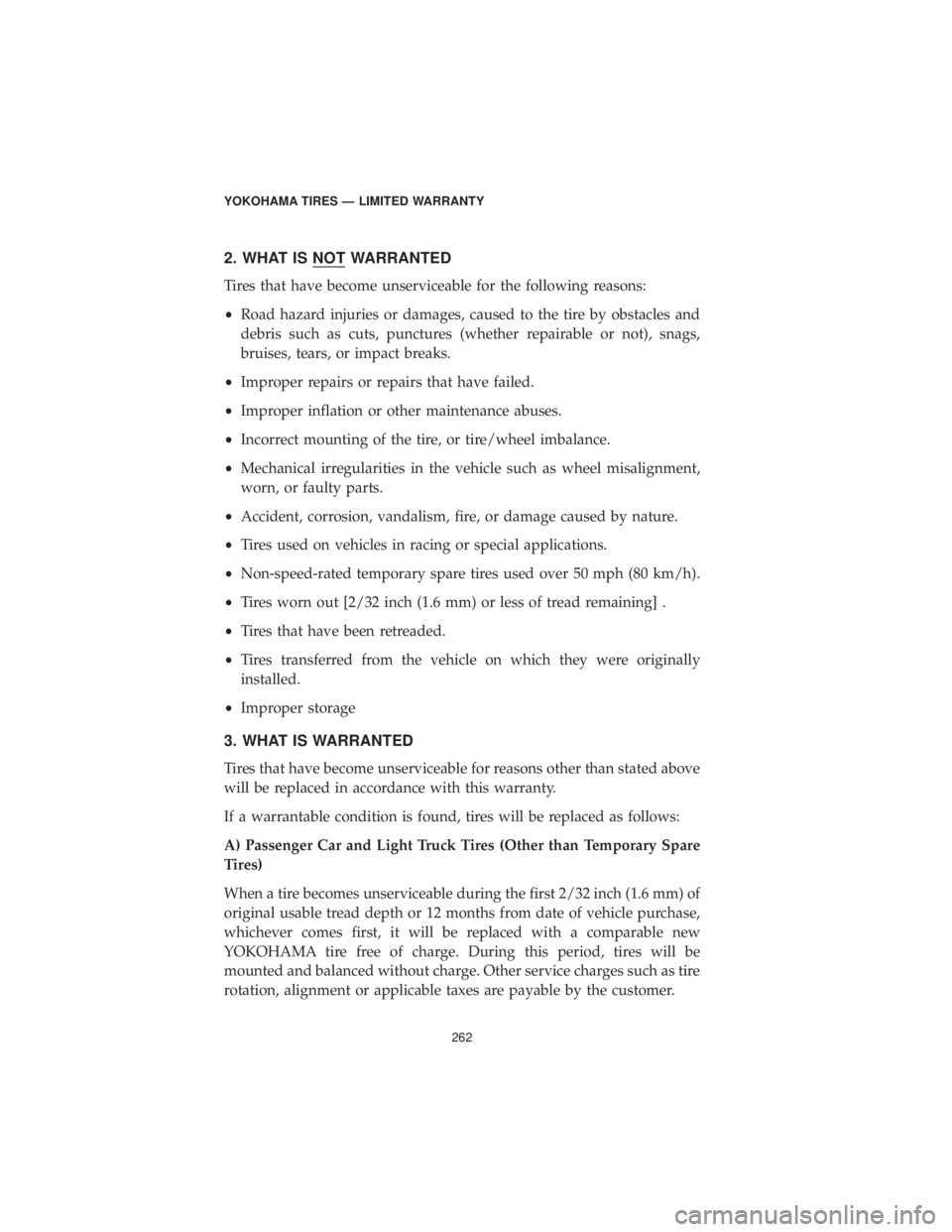2019 DODGE DURANGO SRT wheel
[x] Cancel search: wheelPage 248 of 270

TIRE SPINNING
WARNING!
Spinning a tire to remove a vehicle stuck in mud, snow, or wet grass
can be dangerous. This could cause serious personal injury or death
to a bystander or passenger and extensive vehicle damage. A tire
spinning at a speedometer reading above 35 miles per hour
(55 km/h) can reach a speed capable of disintegrating a tire with
explosive force within a matter of seconds. Under some conditions,
a tire may be spinning at twice the speed shown on the
speedometer. Never spin a tire above a speedometer reading of
35 mph (55 km/h). Never allow anyone to stand near or directly
behind the spinning tire. Do not spin if a drive wheel is off the
ground.
TOWING OR USE OF SLIDE-IN TRUCK CAMPERS
If you are towing a trailer or using a slide-in truck camper, refer to your
vehicle Owner ’s Manual.
WINTER (SNOW) TIRES
Winter driving presents special challenges for vehicle
handling. The use of winter tires, studs, and chains, while
improving traction performance in snow and ice, requires
additional caution and care with regard to braking, corner-
ing, and speed. It is important to drive with care not only
on snow and ice, but on dry and wet roads as well.
WARNING!
Studded tires may require longer braking distances on dry or wet
paved surfaces. Failure to allow for adequate braking distance could
result in serious personal injury or death.
• Traction is considerably reduced as snow tires approach 50% tread
wear, and replacement should be considered in order to maintain
effectiveness in heavy snow conditions.
• Tire speed rating – When lower-speed-rated winter tires replace
higher-speedrated touring and high performance all-season radial
tires, do not exceed the lower-rated speed.
TOYO TIRES – LIMITED WARRANTY
247
Page 251 of 270

WARNING!
•Check inflation pressure before using your spare tire. Failure to
have proper inflation pressure when using your spare tire may
cause loss of vehicle control, which could result in serious personal
injury or death. Maintain spare tire inflation pressures based on
the vehicle Owner ’s Manual or the Tire Information Placard.
•
“T” Type high-pressure temporary spare tires should not be used
with any other wheel, nor should standard tires, snow tires, wheel
covers, or trim rings be used on the high-pressure spare tire wheel. If
you fail to follow this warning, your vehicle’s handling characteris-
tics can be seriously affected. You could have an accident resulting in
serious personal injury or death. Consult your vehicle Owner ’s
Manual for the proper use of your “temporary use” spare tire.
•Do not operate your vehicle with more than one temporary spare in
use (this does not apply to a full size spare), and only operate it at
limited speeds and distances as indicated on the sidewall of the tire.
• The “T” Type temporary spare tire may lower ground clearance
when used. Avoid driving over large obstacles and other road
hazards. Check your vehicle Owner ’s Manual for other special
clearance precautions when using the “T” Type temporary spare
tire provided in your vehicle.
TIRE STORAGE
Tires should be stored indoors in a cool dry place where water cannot
collect inside the tires. The tires should be placed away from harmful
ozone-producing electric generators and motors and sources of heat such
as hot pipes. Storage surfaces should be clean and free of grease, gasoline,
or other substances, which can deteriorate the rubber.
COMPETITION TIRE STORAGE
The rubber compounds used in these tires have unique properties that,
when compared to other tires, can cause them to lose some of their
flexibility when used or handled in conditions below 15° F (-9° C). This
loss in flexibility can lead to potential cracking and other damage to the
tire. To minimize the chances of this happening, you are advised to follow
these instructions:
1. Do not move or operate the car with these tires in conditions below 15°
F (-9° C).
TOYO TIRES – LIMITED WARRANTY
250
Page 253 of 270

speeds in excess of 65 mph may be required, then the following
adjustments or recommendations should be followed:
•At speeds from 66 mph through 75 mph, cold inflation pressure must
be increased 10 psi above the recommended pressures for the load
being carried.
• Do not exceed the maximum inflation pressure of the wheel (all wheels
have maximum allowable inflation pressures).
REPLACEMENT TIRES FOR LIGHT TRUCKS – P-METRIC VS .
LT-TRUCK
Tire installers should exercise extreme caution when replacing tires on
light trucks.
The maximum load capacity stamped on the sidewall of a P-metric tire is
reduced by a factor of 1.1 when used on a light truck, a sport utility
vehicle, or a trailer.
WARNING!
• P-metric and LT-metric tires are not necessarily interchangeable.
P-metric and LT-metric tires follow completely different Load/
Inflation tables and are designed to carry different loads at
different pressures.
(Continued)
TOYO TIRES – LIMITED WARRANTY
252
Page 258 of 270

their use and may vary due to driving habits, service practices,
differences in road characteristics, and climate.
• Traction - The traction grades from highest to lowest are AA, A, B, and
C, and they represent the tire’s ability to stop on wet pavement as
measured under controlled conditions on specified government test
surfaces of asphalt and concrete.
m NOTICE!
The traction grade assigned to tires is based on locked braking (straight
ahead) traction tests and does not include cornering (turning) traction.
• Temperature - The temperature grades are A (the highest), B, and C,
representing the tire’s resistance to the generation of heat and its ability
to dissipate heat when tested under controlled conditions on a
specified indoor laboratory test wheel. Sustained high temperatures
can cause the materials of the tire to degenerate and reduce tire life,
and excessive temperature can lead to sudden tire failure. The grade C
corresponds to a level of performance that all passenger car tires must
meet under the Federal Motor Vehicle Safety Standard No. 139. Grades
B and A represent higher levels of performance on the laboratory test
wheel than the minimum required by law.
WARNING!
The temperature grade is established for a tire that is properly
inflated and not overloaded. Excessive speed, underinflation, or
excessive loading either separately or in combination can cause heat
buildup and possible tire failure. This can cause an accident, which
could lead to serious personal injury or death.
• DOT Quality Grades - All passenger car tires must conform to federal
requirements in addition to these grades.
TOYO TIRES – LIMITED WARRANTY
257
Page 263 of 270

2. WHAT IS NOT WARRANTED
Tires that have become unserviceable for the following reasons:
•Road hazard injuries or damages, caused to the tire by obstacles and
debris such as cuts, punctures (whether repairable or not), snags,
bruises, tears, or impact breaks.
• Improper repairs or repairs that have failed.
• Improper inflation or other maintenance abuses.
• Incorrect mounting of the tire, or tire/wheel imbalance.
• Mechanical irregularities in the vehicle such as wheel misalignment,
worn, or faulty parts.
• Accident, corrosion, vandalism, fire, or damage caused by nature.
• Tires used on vehicles in racing or special applications.
• Non-speed-rated temporary spare tires used over 50 mph (80 km/h).
• Tires worn out [2/32 inch (1.6 mm) or less of tread remaining] .
• Tires that have been retreaded.
• Tires transferred from the vehicle on which they were originally
installed.
• Improper storage
3. WHAT IS WARRANTED
Tires that have become unserviceable for reasons other than stated above
will be replaced in accordance with this warranty.
If a warrantable condition is found, tires will be replaced as follows:
A) Passenger Car and Light Truck Tires (Other than Temporary Spare
Tires)
When a tire becomes unserviceable during the first 2/32 inch (1.6 mm) of
original usable tread depth or 12 months from date of vehicle purchase,
whichever comes first, it will be replaced with a comparable new
YOKOHAMA tire free of charge. During this period, tires will be
mounted and balanced without charge. Other service charges such as tire
rotation, alignment or applicable taxes are payable by the customer.
YOKOHAMA TIRES — LIMITED WARRANTY
262
Page 266 of 270

4. A tread life of up to 3,000 miles (4,800 km) can be expected dependingon road conditions and your driving habits. To conserve tire tread life,
the spare should be returned to the trunk as soon as the standard tire
can be repaired or replaced.
5. Because the YOKOHAMA high pressure spare tire was specifically designed for your car, it should not be used on any other vehicle.
6. Do not use snow chains on your YOKOHAMA high pressure spare. This could cause damage to your vehicle.
7. When the tread wear indicator appears on the tire, replace it only with the same type spare tire.
8. Check the tire’s cold inflation pressure monthly and maintain at 60 psi (4.2 kg/cm2) even when not in use. Do not inflate over 60 psi.
9. The YOKOHAMA high pressure spare tire should not be used with any other rim nor should standard tires, wheel covers, or trim rings be
used on the YOKOHAMA high pressure spare tire rim on which the
YOKOHAMA high pressure spare tire was originally installed.
IMPORTANT SAFETY INFORMATION
All tires require owner maintenance regardless of how well a tire is
constructed. Operational damages such as punctures, impact damage, cuts,
incorrect inflation, etc., may cause tire failure and subsequent personal
injury and/or property damage. Simple operational and maintenance
practices, as listed below, will reduce the chances of tire problems.
Tire Inspection
Visually inspect your tires frequently for any tire damage such as scrapes,
bulges, cuts, nails, irregular wear, etc. resulting from operation. This must
be done immediately after any known or suspected contact with an object
in the road, a pothole, road irregularity or after severe braking. Refer
these conditions to a reputable tire service center for repair or replace-
ment. Never drive on a tire if such conditions appear.
Tire Loading
Never exceed the maximum vehicle load limit listed on the vehicle
placard, tire information label or in the owners manual. Be aware of the
load carrying limits molded into the tire’s sidewall and do not exceed
those limits. Maximum load can only be carried at the maximum cold
inflation pressure indicated on the tire’s sidewall.
YOKOHAMA TIRES — LIMITED WARRANTY
265